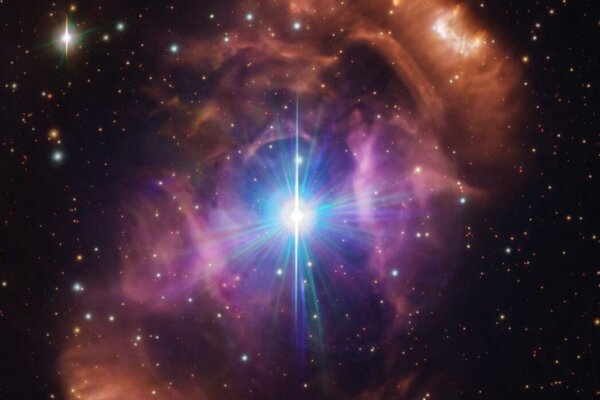
Two massive stars within the stunning “Dragon’s Egg” nebula have intrigued astronomers with a puzzling discovery. While one star possesses a magnetic field like our sun, its companion does not. This phenomenon is rare for such massive stars found within nebulae.
Astronomers believe they have unraveled this mystery by suggesting that stellar fratricide is to blame. The larger star likely absorbed a smaller sibling star, resulting in the creation of a magnetic field due to the mixing of their stellar material during this process.
The violent merger between the two stars is thought to have led to the formation of the nebula visible today, according to Abigail Frost, the lead author of the study published in the journal Science.
Computer simulations had previously predicted that the merging of stellar material during such an event could generate a magnetic field in the resulting combined star.
Hugues Sana, the senior author of the study and an astronomer at KU Leuven in Belgium, stated, “Our study provides observational evidence confirming this scenario.”
These two stars, part of a binary system, are located in the Milky Way galaxy approximately 3,700 light-years away from Earth in the Norma constellation. The researchers utilized data from nine years of observations conducted with the Very Large Telescope in Chile.
The magnetic star is around 30 times more massive than the sun, while its companion is about 26.5 times more massive. They orbit each other at varying distances, ranging from seven to 60 times the distance between Earth and the sun.
The Dragon’s Egg nebula got its name due to its proximity to a larger nebula complex known as the Fighting Dragons of Ara. The stars within the Dragon’s Egg initially formed as a triple system approximately 4-6 million years ago, with the merger between the two innermost stars resulting in the creation of the nebula.
This cosmic event occurred relatively recently, about 7,500 years ago, based on the expansion velocity of the nebula’s material. The nebula primarily consists of hydrogen and helium, with an unusually high nitrogen content resulting from the merger.
While many sun-sized stars possess magnetic fields, explaining their presence in massive stars like the ones in this binary system is more challenging. This merger scenario provides a plausible explanation for the magnetic field in these massive stars.
Approximately 7 percent of massive stars are known to have magnetic fields, with the second star in this binary system remaining devoid of such a field.
Stellar magnetic fields hold significant energy and can impact Earth’s atmosphere, causing phenomena like auroras and disruptions to communication systems.
The stunning image of the nebula captured in the study showcases the intricate physics and chemistry at play, resulting in its beautiful structure.
By Will Dunham





